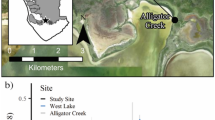Abstract
We examined the areal extent and changes in thefreshwater tidal wetlands along a 56.4 km and a80.6 km reach of the Delaware River between Chester,Pa. and Trenton, N.J. Most of the remainingfreshwater tidal wetlands of the Delaware River arefound along tributaries which drain the coastal plainof New Jersey. We identified polygons of marsh, mud,and open water using color infrared aerial photographyobtained at low tide in 1977 and 1978. Marsh polygonswere classified into either high marsh or low marshaccording to the dominant visual signature of thevegetation of each polygon, and placed in a geographicinformation system for subsequent analysis. The totalarea of marsh within the two reaches totaled 1416 ha,of which 71% was high marsh and 29% low marsh. Asite re-examination in 1997 and 1998 of marsh arearepresenting 32% of the total marsh area revealedthat, while the total area of wetland appears to haveremained constant, high marsh vegetation along thelower reaches of the tributaries has been replaced bylow marsh vegetation. The fraction of the sample thatwas low marsh increased from 9% in 1977–78 to 34% in1997/8.
Similar content being viewed by others
References
The Academy of Natural Sciences Patrick Center for Environmental Research. 1998. Impact of Aquatic Vegetation Water Quality of the Delaware River. Final Report to the Delaware River and Basin Commission, Lewes, DEL.
Cowardin, L.M., Carter, V., Golet, F.C. and LaRoe, E.T. 1979. Classification of Wetlands and Deepwater Habitats of the United States. Fish andWildlife Service U.S. Department of the Interior. 103 pp.
NOAA. September, 1997. Relative Sea Level Trends. NOAA/NOS National Water Level Observation Network. <http://www.opsd.nos.noaa.gov/seatrnds.html>. 30 September, 1998.
Orson, R.A., Simpson, R.L. and Good, R.E. 1990. Rates of sediment accumulation in a tidal freshwater marsh. Journal of Sedimentary Petrology 60: 859–869.
Simpson, R.L., Good, R.E., Leck, M.A. and Whigham, D.F. 1983a. The ecology of freshwater tidal wetlands. BioScience 33: 255–259.
Simpson, R.L., Good, R.E., Dubinski, B.J., Pasquale, J.J. and Philipp, K.R. 1983b. Flux of Heavy Metals in Delaware River Freshwater Tidal Wetlands. Final Report, Center for Coastal and Environmental Studies. Rutgers - The State University of New Jersey.
Tiner, R.W. jr., 1985. Wetlands of New Jersey. U.S. Fish and Wildlife Service, 117 pp.
Thunhorst, G.A. 1993. Wetland Planting Guide for the Northeastern United States. Environmental Concern, Inc.
Wetlands Research Associates. 1995 Tidal Wetlands Characterization. Then and Now. Report to the Delaware River and Basin Commission, Lewes, DEL.
TheWorking Group on Sea Level Rise and Wetland Systems. 1997. EOS, Transactions, American Geophysical Union 78: 257–261.
Author information
Authors and Affiliations
Rights and permissions
About this article
Cite this article
Field, R., Philipp, K. Vegetation changes in the freshwater tidal marsh of the Delaware estuary. Wetlands Ecology and Management 8, 79–88 (2000). https://doi.org/10.1023/A:1008480116062
Issue Date:
DOI: https://doi.org/10.1023/A:1008480116062




